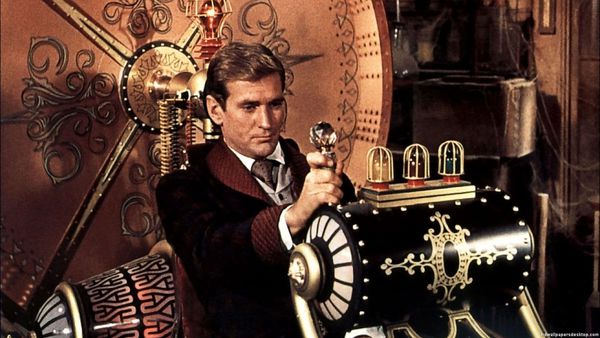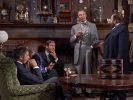Eye For Film >> Movies >> The Time Machine (1960) Film Review
The Time Machine
Reviewed by: Jennie Kermode

In the year 1900, an inventor by the name of H George Wells announces to his friends that he has built a machine which will enable him to travel in time. Naturally, they're a bit dubious, and one of them warns him that if he really can do what he claims, there could be serious dangers. What neither of them anticipates is the nature of those dangers, for as our hero undertakes his journey the things he witnesses threaten to destroy his faith in humanity - and when he eventually decides he's gone as far as he wants to, the humans he finds are not what they used to be.
Combining then fresh ideas about the future of evolution, the development of military technology and changing modes of information storage, HG Wells' 1895 debut novel was extraordinarily visionary. By 1960, of course, a lot of its future history was already known, so a little of the thrill of seeing how much Wells himself predicted correctly is lost, but Rod Taylor, in the lead, effectively shows us the hero's perspective, reminding viewers of the loss of innocence that came with the wars and the atom bomb. The bleakness of Wells' expectations - which would gradually lead him to despair over the course of his life - seems to give way when our hero arrives in a beautiful garden. It's here that he meets the beautiful Weena (Yvette Mimieux), and that he learns of the Morlocks, the cannibal race who live underground and farm the child-like Eloi.

It's here that the film diverges significantly from the book, presenting us with a simplified battle between good and evil, a depiction lacking the sympathy for the subterranean hinted at in Wells' text. Taylor, being rather more sprightly than the usual inventor stereotype (just 29 when the film was made), makes an effective action hero without losing the important intellectual dimension, but the film makes itself more palatable for US audiences of the period by eliding any discussion of the class dynamics behind the separation of its two races. It also places the Eloi, despite their apathy and illiteracy, as the clear inheritors of what it means to be human, defining the Morlocks purely as monsters.
Despite these alterations, the film retains the sense of existential dread that gives the story its power - each man must, after all, admit that he contains within himself the seed of a Morlock. It's also successful as an adventure tale, with some genuinely creepy moments despite the bad make-up, and with dramatic action scenes that recall Taylor's early days as a radio Tarzan. He and Mimieux have sufficient chemistry to make the romance feel real and work around the awkward power imbalance between the chronologically complicated couple.
Beyond all this, it's the little things that really make the film something special. The depiction of the world changing around our hero as he journeys through time is beautifully handled, and the clothes shop through whose window he watches years pass in a parade of changing hemlines adds a nice touch of humour. Overall, this is one of George Pal's most polished pieces of work and it has withstood the passage of time very well indeed.
Reviewed on: 09 Jan 2015















